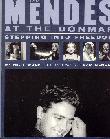SEARCH
REVIEWS
FEATURES
NEWS
Etcetera and
Short Term Listings
LISTINGS
Broadway
Off-Broadway
BOOKS and CDs
OTHER PLACES
Berkshires
London
LA/San Diego
Philadelphia
Elsewhere
QUOTES
On TKTS
LETTERS TO EDITOR
FILM
LINKS
MISCELLANEOUS
Free Updates
Masthead
Writing for us
A CurtainUp  London Review
London Review
 London Review
London ReviewThe Knight of the Burning Pestle
|
Hence my blue apron! Yet in remembrance of my former trade, upon my shield shall be portrayed a burning pestle, and I will be called the Knight o'th' Burning Pestle.
---- Rafe |
The play begins as a comic romance called The London Merchant with the stock scenario of thwarted love between a trustworthy but mistreated apprentice and a modest, devoted maiden. Just as this narrative is initiated, two members of the audience, passionate fans of their city and chivalric stories, object. Their heckling escalates into directorial intervention, as they install their own servant Rafe (Rafe Spall) onstage to promote civic glory and lofty heroism. The two dramas co-exist within the one play, and if ever Rafe's part is sidelined, his masters ensure that he gets more stage time and attention. Therefore, while the lovers flee tyrannical authority and scheme to achieve their union, Rafe pursues various quixotic adventures, such as battling a monstrous cave-dwelling giant.
The design by Jonathan Fensom reflects the play's inherent duality. Elements of Jacobean theatrical authenticity are juxtaposed with urban modernity. The Elizabethan costume-clad players ride steeds represented by diminutive stunt bikes. The scruffy Rafe wears jeans and trainers and is accompanied by two chav minions, sporting baseball caps and puffer jackets. According to 17th century theatrical convention, the female characters are played by men, but little attempt is made to disguise their masculinity. They might wear hoop skirts and bodices, but no wigs grace their bald heads.
This distinctively dichotomous style, however, loses some of its evocative power because of the Barbican's spatial quality. The currently converted auditorium has superimposed blocks of seating and gives the theatre a strangely empty, blank character. For the metatheatrical impetus to be more effective, there needs to be a clearer distinction between the play's reality and the audience's reality, so that the breaching of the two worlds is more emphatic. The Globe theatre would have been a more apt setting, where the elaborately artificial world of the theatre is more obvious. Moreover, into this vastly cavernous void, much of the play's energy seems to evaporate.
This is a shame, because the performances are lively, well-directed and entertaining. In particular, Toby Dantzic is an engagingly sweet Luce, the faithful, gentle lover. His falsetto singing was delightful and provided a glimpse into a more successfully parodic production. The cross-dressing female characters, in fact, work very well in this production, because the stylised theatrical charade is so unmistakably manifest. Rafe Spall plays the unlikely hero Rafe, reincarnating the 17th century grocer's boy into a lager-swilling football patriot. Furthermore, Ryan Early as Jasper exudes energetic integrity as the impetuous, devoted lover.
To produce this play is an extremely ambitious project. For parody to succeed, its object needs to be relevant or at least familiar. Beaumont's 400 year-old caricatures, however brilliantly and wittily drawn, are simply no longer recognizable as a social phenomenon to an audience of the 21st century. Therefore, much of the play's humour is of erudite, rather than comical, interest. An esoteric few will find the elaborate dialectic established between the two theatrical genres blissful, but most will find it difficult to comprehend or enjoy. Paradoxically, however, the very obscurity of the satire makes this an exceptional opportunity to experience so rarely-staged a play. The breathtaking virtuosity of Beaumont's writing encompasses a broad range of styles which he mimics and mocks with unerring skill. This anarchic play, which deliberately disregards coherence, has a startlingly fresh structure and intriguing, if sometimes obsolete, social comment.
| THE KNIGHT OF THE BURNING PESTLE
Written by Francis Beaumont Directed by Anna Mackmin Starring: Rafe Spall With: Spencer Brown, Toby Dantzic, Felix Dexter, Ryan Early, Tim Freeman, Robert Galas, Simon Green, Ingrid Lacey, Geoff Leesley, Tim Potter, Dale Superville Design: Jonathan Fensom Composer: David Downes Lighting: Paul Anderson Sound: Paul Arditti Running time: Two hours fifteen minutes with one interval Box Office: 0845 120 7554 Booking to 8th October 2005 Reviewed by Charlotte Loveridge based on 29th September 2005 performance at the Barbican Theatre, Silk Street London EC2 (Tube: Barbican) |





